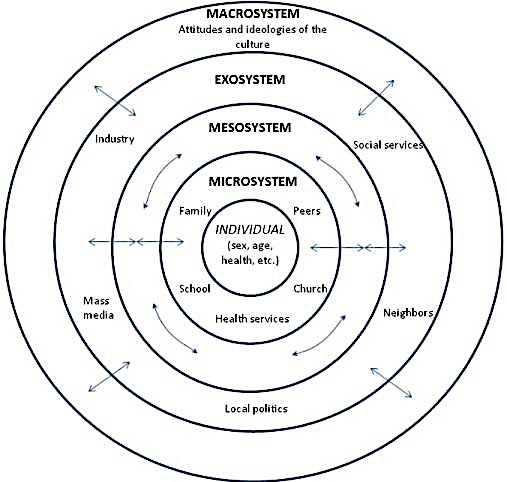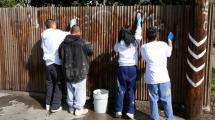Youth who receive special education services under the Individuals with Disabilities Education Act (IDEA 2004) and especially young adults of transition age, should be involved in planning for life after high school as early as possible and no later than age 16. Transition services should stem from the individual youth’s needs and strengths, ensuring that planning takes into account his or her interests, preferences, and desires for the future.
Environmental Influences
The environments that surround adolescents contribute to their health and wellbeing both directly and indirectly. A clear way to look at all these influences is through the social-ecological model, developed by Urie Bronfenbrenner, which is often used within public health and human service settings to help explain an issue or situation and identify strengths and areas of weakness.1
The different environments in this model (Figure 1) typically include:
- the individual: the adolescent, or person of focus
- the microsystem: relationships with family, school personnel, peers, health service professionals
- the mesosystem: interactions between microsystems (e.g., families and teachers)
- the exosystem: local politics, mass media
- and the macro system: national policies, attitudes of the culture.2
Figure 1: The Social-Ecological Model

Image Source: https://en.wikipedia.org/wiki/Ecological_systems_theory
Case Example #1 — Social Media
The social-ecological model can help break down a complex situation and pinpoint areas where supports may be needed. The effects of social media on adolescents is a great example for showing how the ecological model can clarify an issue, figure out who is involved, and what is an appropriate way to respond.
Social media includes websites and applications, where people can create and share content with others online and/or participate in social networking. It is also a place where people can build online communities. Social media is commonly used by adolescents, with 95 percent of U.S. teens reporting having access to a smartphone and 45 percent reporting that they are online nearly all of the time.3 While social media can have many positive influences4 (e.g., supportive online communities), it can also have negative effects on youth. One negative consequence of social media for youth is bullying, which can lead to increases in depressive symptoms, low self-esteem and other mental health issues.5 Social media is present throughout many environments, following an individual wherever they are, including at home, in school, at work, and so on. Bullying can take the form of online harassment while also following an adolescent into real life while at school or in their neighborhood, creating a constant negative presence.
Research has found that adolescents who experience online harassment are more resilient when they also have a supportive social environment at school.6 This information in conjunction with the socio-ecological model could help practitioners (PDF, 2 pages) develop anti-bullying initiatives in their schools, or to help individual youth and their friends/peers develop plans for creating more socially-supportive school environments. This would also likely need the involvement of family and positive parenting practices, to help support adolescent connectedness and potentially involvement of the local community.
The socio-ecological environments relevant to a social media bullying issue would include the home, school, and local community; and the key players within those environments would include the individual, family members, peers, school personnel, and the local community. With this information, a practitioner or guardian could start to develop a plan of action.
Case Example #2 — Violence Prevention
The Centers for Disease Control provides another comprehensive example of the social ecological model, looking at the public health issue of violence prevention. This example (Figure 2) uses overlapping rings in the model to “illustrate how factors at one level influence factors at another level.” It also emphasizes the need for acting across multiple levels of the model to successfully implement prevention efforts that are effective and sustainable.
Figure 2: The Social-Ecological Model in Violence Prevention

Image Source: https://www.cdc.gov/violenceprevention/publichealthissue/social-ecologicalmodel.html
The following breaks down each level of the social-ecological model within the violence prevention example:7
- Individual — Biological and personal history factors that increase the likelihood of becoming a victim or perpetrator of violence, such as age, education, income, or substance use. Prevention strategies at the individual level should promote attitudes, beliefs, and behaviors that prevent violence, such as providing education and life skills training.
- Relationship — Close relationships that may increase the risk of experiencing violence as a victim or perpetrator, such as a person’s closest social circle-peers, partners and family members who can influence their behavior and contribute to their experience. Prevention strategies for this level could include parenting or family-focused programs, mentoring, peer programs to reduce conflict and/or promote healthy relationships.
- Community — Settings such as schools, workplaces, and neighborhoods that may increase the risk of experiencing violence as a victim or perpetrator. Prevention strategies could include efforts to impact the social and physical environment such as reducing social isolation, improving economic and housing opportunities in neighborhoods, and improving climate, processes, and policies within school and workplace settings.
- Societal — Social and cultural norms that support violence as an acceptable way to resolve conflicts, as well as health economic, educational and social policies that help maintain economic or social inequalities between groups in society.
Resources
Adolescent Health: What Works In Schools
The Centers for Disease Control and Prevention’s Division of Adolescent and School Health has established an evidence-based approach to school-based HIV and STD prevention, which includes quality sexual health education, connecting students to sexual health services, and establishing safe and supportive school environments. These strategies benefit all students and can be tailored to address health outcomes other than sexual risk behaviors, including high-risk substance use, violence victimization, and mental health. Taking this approach improves protective factors and health outcomes for students that can last a lifetime.
Youth Risk Behavior Survey: Data Summary and Trends Report 2009-2019
This report from the Centers for Disease Control and Prevention’s Division of Adolescent and School health (DASH) provides data summary and trend information on varying topics, including sexual behavior, high-risk substance use, violence victimization, mental health and suicide, and minority youth.
Talk. They Hear You.
The “Talk. They Hear You.” Campaign, from the Substance Abuse and Mental Health Services Administration, aims to reduce underage drinking and substance use among youth under the age of 21 by providing parents and caregivers with information and resources they need to address alcohol and other drug use with their children early.
Parent Engagement: Strategies for Involving Parents in School Health
This webpage from the Centers for Disease Control and Prevention was developed for school administrators, educators, support staff and families. It describes parent engagement and identifies specific strategies and actions that schools can take to increase parent engagement in schools’ health promotion activities.
Positive Parenting Practices
This webpage from the Centers for Disease Control and Prevention provides information on positive parenting practices and presents information on the protective factors related to parenting practice topics, such as “parental monitoring” and “father's influence.”
Adolescent Connectedness Has Lasting Effects
This webpage from the Centers for Disease Control and Prevention presents findings that adolescent connectedness to school and family is an important protective factor for youth that has lasting effects.
Increasing Our Impact by Using a Social-Ecological Approach (PDF, 5 pages)
This research brief developed for the Family & Youth Services Bureau, provides a comprehensive explanation of the ecological model and how it can be used effectively with adolescents to help improve their health outcomes.
Build a Safe Environment
This webpage from the federal website StopBullying.gov provides information on how to create a safe and supporting school environment as a means to preventing bullying.
Digital Citizenship Skills
This fact sheet from StopBullying.gov describes appropriate, responsible behavior when using technology. When children learn positive online behaviors, social media can be used in productive ways.
Bystanders are Essential to Bullying Prevention and Intervention
This fact sheet from StopBullying.gov explains how a bystander can make a positive difference in a bullying situation, particularly for the youth who is being bullied.
References
Other Resources on this Topic
Agencies
Announcements
Collaboration Profiles
Data Sources
Departments
Feature Articles
Programs
Publications
Resources
Technical Assistance
Tools & Guides
Training Resources
Videos & Podcasts
Websites
Youth Topics
Youth Briefs
Research links early leadership with increased self-efficacy and suggests that leadership can help youth to develop decision making and interpersonal skills that support successes in the workforce and adulthood. In addition, young leaders tend to be more involved in their communities, and have lower dropout rates than their peers. Youth leaders also show considerable benefits for their communities, providing valuable insight into the needs and interests of young people
Statistics reflecting the number of youth suffering from mental health, substance abuse, and co-occurring disorders highlight the necessity for schools, families, support staff, and communities to work together to develop targeted, coordinated, and comprehensive transition plans for young people with a history of mental health needs and/or substance abuse.
Nearly 30,000 youth aged out of foster care in Fiscal Year 2009, which represents nine percent of the young people involved in the foster care system that year. This transition can be challenging for youth, especially youth who have grown up in the child welfare system.
Research has demonstrated that as many as one in five children/youth have a diagnosable mental health disorder. Read about how coordination between public service agencies can improve treatment for these youth.
Civic engagement has the potential to empower young adults, increase their self-determination, and give them the skills and self-confidence they need to enter the workforce. Read about one youth’s experience in AmeriCorps National Civilian Community Corps (NCCC).






